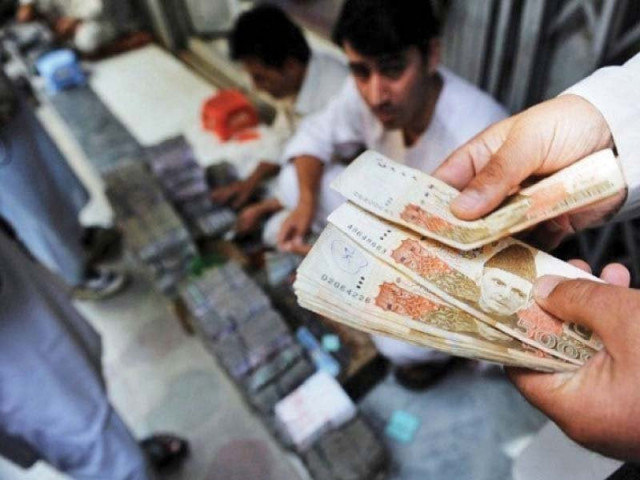With double-digit growth, govt’s debt rises to Rs22.9tr
Net addition of Rs2.14 trillion made in eight months of current fiscal year, 10.3% higher than that in June 2017

The growing debt burden has triggered a national debate on sustainability of the country’s macroeconomic framework. PHOTO: FILE
The State Bank of Pakistan’s (SBP) latest central government debt bulletin for the period of July-February revealed that the finance ministry incurred debt, which was far more than it was required, abandoning the path of fiscal prudency.
The SBP data showed that the federal government’s debt ballooned to Rs22.9 trillion by the end of February. There was a net increase of Rs2.14 trillion in the total central government debt in the first eight months of the fiscal year, which was 10.3% higher than that in June 2017.
For the current fiscal year 2017-18, parliament had approved the budget deficit target of 4.1% of GDP or Rs1.48 trillion. However, the net addition of Rs2.14 trillion to the federal government debt in just eight months was equal to 6% of GDP.
Risks to Pakistan’s economic outlook have increased: IMF
One reason was that in December the government devalued the rupee against the US dollar by 5%, which increased the external debt in rupee terms.
However, SBP’s first-half report revealed another pattern. “The domestic borrowings also increased slightly during the (first half) period, due to the buildup of government’s deposits with the banking system, which increased to Rs168.3 billion during first half of the fiscal year,” according to the central bank report released on Friday. In a footnote, the SBP noted that during the first half of the last fiscal year, the buildup of deposits was only Rs33.1 billion.
The status of the government’s deposits for July-February period was not known.
The growing debt burden has triggered a national debate on sustainability of the country’s macroeconomic framework.
The federal government’s total domestic debt increased to roughly Rs16 trillion -an addition of Rs1.1 trillion or 7.4% in eight months. The domestic debt structure underwent a drastic change, which has already exposed the government to refinancing risks.
The share of short-term public debt increased alarmingly to 50.7% or Rs8.1 trillion by the end of February. At the same time last year, the short-term domestic debt stood at 44% or Rs6.6 trillion. The short-term debt grew Rs1.53 trillion or 23.4% in eight months. The rise in short-term debt was the result of growing dependence on borrowing through sale of market treasury bills (MTBs).
The federal government’s total borrowing through MTBs increased to almost Rs5 trillion, up 21.6% or Rs882 billion in eight months.
Similarly, the MTBs issued to replenish cash rose to Rs3.2 trillion, a net addition of Rs652 billion from July through February. The mounting short-term debt suggests that banks were not willing to provide long-term loans in anticipation of increase in interest rates, according to analysts.
Another reason was that the federal government started relying on the central bank for financing its deficit, which changed the debt structure. The change in the composition of domestic debt suggests that the government could not fully implement its second Medium-Term Debt-Management Strategy 2016-19 that intends to lengthen the maturity profile to reduce the refinancing risk.
In contrast to short-term debt, the country’s long-term debt decreased 5.3% to Rs7.86 trillion. Its share was 56% in the total domestic debt at the end of June 2017, which reduced to 49.3% by February this year.
The share of bonds issued by the federal government shrank from Rs4.8 trillion to Rs4.2 trillion despite an overall increase in public debt. A net reduction of Rs541 billion or 11.3% in bonds’ holdings indicates that banks are not willing to lock funds for longer periods.
However, the debt acquired through the sale of prize bonds increased from Rs747 billion to Rs808 billion at the end of February 2018.
In its first half yearly report, the central bank wrote that with the expectation of monetary tightening that prevailed throughout the first half, banks’ interest in PIB auctions was almost nonexistent. In absolute terms, banks offered only Rs158.4 billion in PIB auctions during the first half compared to Rs9.1 trillion offered in T-bills auctions, according to the central bank. Within treasury-bills, around 85.6% of the offers were for 3-month treasury-bills only.
The external debt during the first eight months of the fiscal year also increased by 17.6% to Rs7 trillion. There was a net increase of Rs1.03 trillion in the external debt from July through February. One reason for that was the depreciation of rupee against the US dollar. These figures are exclusive of Rs691 billion IMF debt, which is the responsibility of the central bank.
Foreign exchange: SBP's reserves drop $107m, stand at $12.1b
In its half yearly report, the SBP stated that strengthening of other currencies against US dollar also resulted in $669.3 million as revaluation losses. The dollar weakened against euro and SDR by 4.9% and 2.3% respectively, which added significantly to dollar value of Pakistan’s external debt.
Published in The Express Tribune, April 8th, 2018.
Like Business on Facebook, follow @TribuneBiz on Twitter to stay informed and join in the conversation.



















COMMENTS
Comments are moderated and generally will be posted if they are on-topic and not abusive.
For more information, please see our Comments FAQ